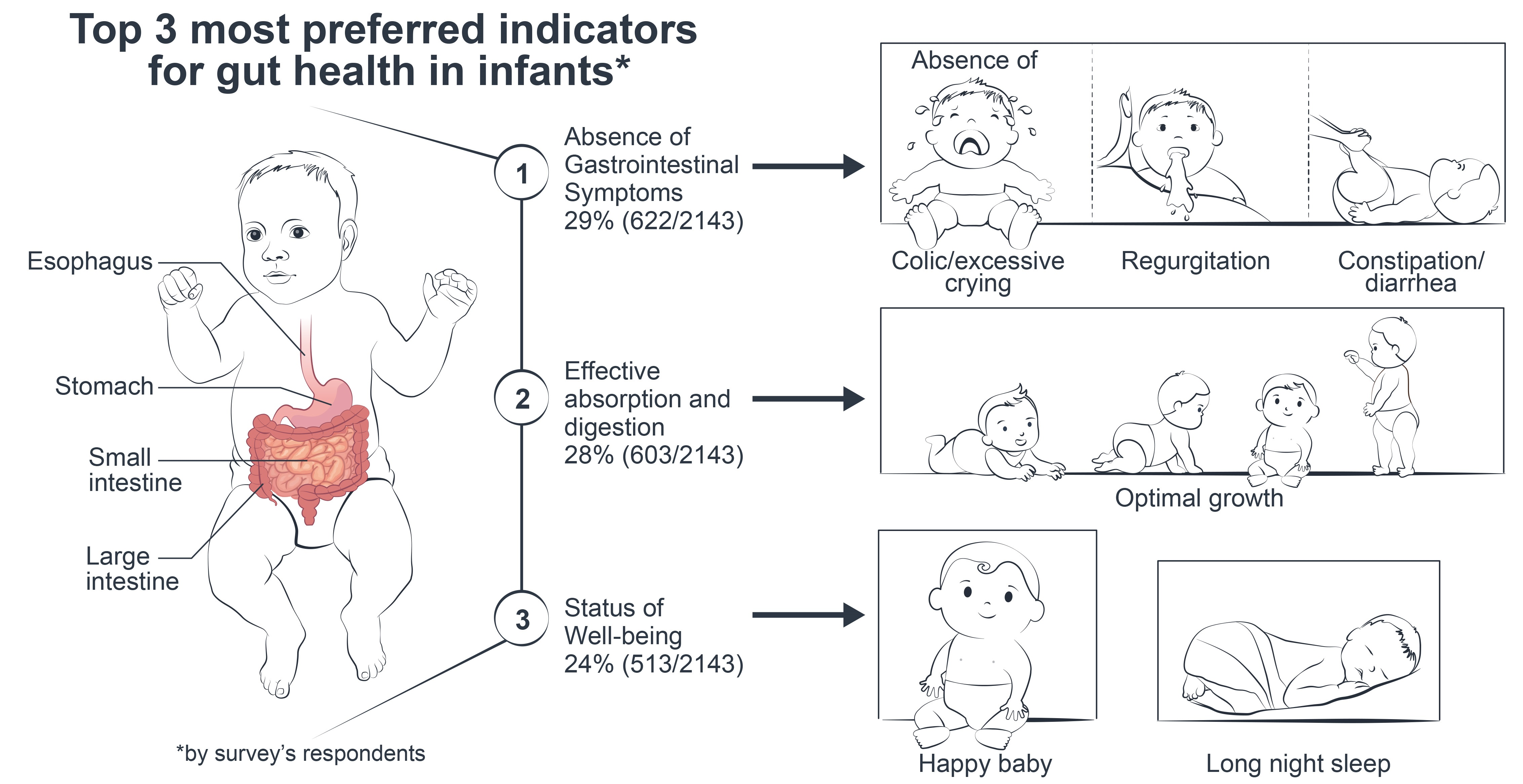Description
- A healthy gut during early childhood is important.[1]
- Infants undergo rapid organ development, including the gastrointestinal (GI) tract, during the first months of life.[1:1]
- The stomach volume capacity of an infant is only about 10% of that of an adult.
- The activity of various digestive enzymes, especially lipase and protease, is quite limited during the first few months of life in comparison to the levels in adulthood.[1:2]
- The GI tract motility and its functionality will progressively mature over time.[1:3]
- An effective GI absorption and digestion of nutrients in young children will result in normal nutritional status and normal growth.[1:4]
- An absence of gastro-esophageal reflux (disease), constipation, celiac disease, and many other GI illnesses indicates, of course, the importance of an “absence of disease” when describing gut health.[1:5]
- There are currently no guidelines or recommendations for healthcare professionals (HCPs) on how to assess a healthy gut during infancy and toddlerhood.[1:6]
- The preferred standard indicators used to assess infant gut health:
- the absence of GI symptoms
- normal growth for effective digestion and absorption
- general well-being.
- The younger an infant is, the more important adequate growth is.[1:7]
- Therefore the most important determinator of healthy gut function in young children is digestion and absorption of nutrients resulting in optimal growth.[1:8]
- Thus, optimal growth can be considered as a proxy for adequate digestion and absorption.[1:9]
- In contrast, rapid weight gain resulting in being overweight cannot be used as a marker of efficient absorption and digestion functions, although it is a consequence of an imbalance between caloric intake and energy expenditure.[1:10]
- Therefore the most important determinator of healthy gut function in young children is digestion and absorption of nutrients resulting in optimal growth.[1:8]
- The second-best indicator for infant gut health is the ‘absence of GI symptoms related to functional GI disorders.[1:11]

- In early life, functional gastrointestinal disorders (FGIDs), which consist mainly of gastroesophageal reflux/regurgitation, colic/excessive crying/irritability, and constipation, are commonly reported.[1:12]
- As the large intestine of an adult harbors more than 1014 bacteria, an optimal gut microbiota or an absence of dysbiosis is also an important aspect to consider when determining gut health also in children.[1:13]
- The microbiota in combination with the GI barrier function contributes to the overall immune system, GI tract function, and general feelings of well-being through the gut–brain communication.[1:14]
- Overall wellbeing could be part of the gut health indicators.[1:15]
- Gut health indicators include a normal quality of life in adulthood, a happy and smiling baby, and/or a long night’s sleep in young infants.[1:16]
Title: Early-Life Gut Health Indicators and Reported Prevalence of Infant Functional Constipation by Healthcare Professionals
Publication: MDPI: Nutrients
Archive: archive ↩︎ ↩︎ ↩︎ ↩︎ ↩︎ ↩︎ ↩︎ ↩︎ ↩︎ ↩︎ ↩︎ ↩︎ ↩︎ ↩︎ ↩︎ ↩︎ ↩︎Title: An Investigation into the Impact of Maternal Dietary Intakes, Well-being and Breastfeeding on Longitudinal Child Health
Publication: Research Repository UCD ↩︎Title: Human milk oligosaccharides, antimicrobial drugs, and the gut microbiota of term neonates: observations from the KOALA birth cohort study
Publication: Gut Microbes
Archive: archive ↩︎Title: Prebiotic Activity of Vaginal Lactobacilli on Bifidobacteria: from Concept to Formulation
Publication: ASM Journals: Microbiology Spectrum
Archive: archive ↩︎Title: Breastfeeding enrichment of B. longum subsp. infantis mitigates the effect of antibiotics on the microbiota and childhood asthma risk
Publication: Science Direct: Med
Archive: archive ↩︎Title: The gut metagenome harbors metabolic and antibiotic resistance signatures of moderate-to-severe asthma
Publication: bioRxiv
Archive: archive ↩︎Title: Early-life exposure to per- and polyfluoroalkyl substances and infant gut microbial composition
Publication: ENVIRONMENTAL EPIDEMIOLOGY
Archive: archive ↩︎
